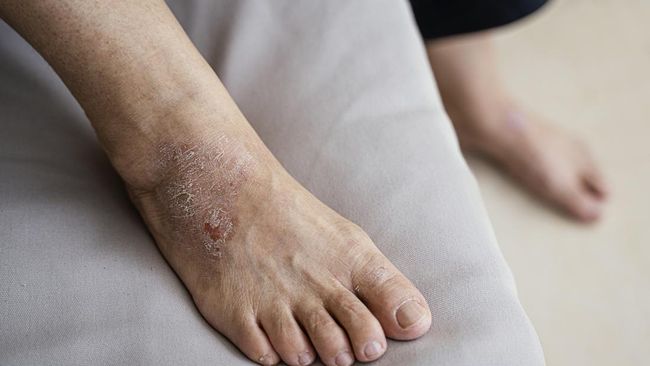CNN Indonesia
Wednesday, 20 Sep 2023 13:15 IWST
Illustration. Eczema can actually occur on any part of the skin on the body, but most often occurs on the feet. Here’s how to treat eczema on the feet. (iStockphoto/ozgurdonmaz)
Jakarta, CNN Indonesia —
How to treat eczema on the feet can actually be done by maintaining your lifestyle so you don’t need to rush to take medication.
But before discussing how to treat it, what is it actually? eczema and what are the causes? The following is the explanation.
What is eczema?
Eczema is inflammation of the skin which is accompanied by redness, itching, blistering, cracking, roughness until soft lumps filled with fluid appear. Eczema is also known as dermatitis as quoted from Medical News Today.
Eczema can actually occur on any part of the skin on the body, but most often occurs on the feet. Starting from the top of the foot to the ankle.
Usually, eczema that occurs on the feet develops before or during a person’s adulthood. This means that a person may experience flare-ups that come and go with certain triggers, depending on the type of eczema.
Causes of eczema
In general, here are some causes of eczema on the feet.
Genetic factors. Environmental conditions. Allergies to certain food ingredients. Allergies to elastic materials in socks or preservatives in shoes. Exposure to allergens such as scented products. Dry skin. Hot. Excessive sweating. Chlorine. Hot water. Dry air or sudden changes in temperature. Stress.
Types of eczema
The following are the types of eczema on the feet.
1. Atopic dermatitis
Atopic dermatitis is the most common type of eczema that can appear on any part of the body, including the ankles.
Usually atopic dermatitis occurs in children with general symptoms of itching and redness of the skin.
2. Dyshidrotic eczema
Dyshidrotic eczema is a type of eczema with symptoms of pain and blistered skin on the feet and hands.
Some people who have dyshidrotic eczema will feel very miserable. Because, this condition usually disappears after a few weeks, some even persist throughout life.
3. Neurodermatitis
Neurodermatitis is a type of eczema with symptoms of itching and thick patches of skin on the ankles, hands and other parts of the body.
4. Static dermatitis
Static dermatitis is a type of eczema that usually occurs on the top of the foot to the lower leg. Symptoms include a change in skin color to brownish orange spots.
How to Treat Eczema on the Feet
s Hand Applying Cream On His Feet” title=”foot care illustration” />Illustration. How to treat eczema on the feet. (iStockphoto/AndreyPopov)
After knowing the causes and types, here’s how to treat eczema on the feet as quoted from Very Well Health.
1. Compress with a cold towel
When eczema appears, try compressing the inflamed skin area with a cold towel or ice. This can soothe red, inflamed and itchy skin.
2. Avoid warm baths
As much as possible, avoid taking warm showers, especially soaking in warm water for a long time. If you have to, take a short shower or wait for the water temperature to get colder.
The thing is, bathing or soaking in warm water can make the skin drier. This condition can trigger redness and inflammation that becomes worse when the eczema recurs.
3. Use moisturizer
When eczema appears, the skin usually becomes drier, so try using a moisturizer to add moisture to the skin so it doesn’t get too dry.
4. Use allergen-free products
Some eczema occurs because the skin is allergic to products that contain allergens. Therefore, use allergen-free skin cleaning and moisturizing products.
5. Avoid triggers
It is important to know that eczema can occur because there is a trigger. Therefore, as much as possible avoid these triggers.
For example, does eczema appear due to certain environmental conditions, consumption of certain foods, stress, or even lack of sleep. Likewise with the use of certain materials in socks and shoes.
6. Manage stress
Excessive stress can increase inflammation when eczema flares. This will make it difficult for the skin to repair so that the redness and itching becomes more pronounced.
Therefore, try to manage your stress. This can be done by avoiding things that can cause stress, meditating, breathing air outside the home, improving a nutritious diet, exercising, and seeking social support.
7. Consume nutritious food
Consuming nutritious foods can relieve eczema, such as paying attention to food intake that does not contain allergens, hydrating the body with sufficient fluids, and having whole foods.
Some recommended consumption of nutritious foods, namely those containing omega-3 fatty acids, vitamin D, vitamin C, probiotics, zinc, healthy oils, and mineral water.
That’s an explanation of eczema, starting from the causes, types, and how to treat eczema on the feet. Hope it is useful.
(us/fef)
Watch the Video Below:
2023-09-20 06:15:00
#Ways #Treat #Eczema #Feet #Types


